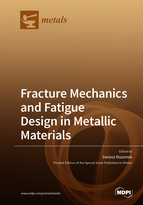Fracture Mechanics and Fatigue Design in Metallic Materials
A special issue of Metals (ISSN 2075-4701). This special issue belongs to the section "Metal Failure Analysis".
Deadline for manuscript submissions: closed (30 September 2021) | Viewed by 35664
Special Issue Editor
Interests: fracture mechanics; fatigue; failure analysis; metallography; welding; fatigue crack growth; fatigue life
Special Issues, Collections and Topics in MDPI journals
Special Issue Information
Dear Colleagues,
Devices, working structures, and their elements are subjected to the influence of various loads. These can be static, cyclic or dynamic loads. The accumulation of damage and the development of fatigue cracks under the influence of loads is a common phenomenon that occurs in metals. To slow down crack growth and ensure an adequate level of safety and optimal durability of structural elements, experimental tests and simulations are required to determine the influence of various factors. Such factors include, among others, the impact of microstructure, voids, notches, the environment, etc. Research carried out in this field and the results obtained are necessary to guide development towards the receipt of new and advanced materials that meet the requirements of the designers. This Special Issue aims to provide the data, models, and tools necessary to perform structural integrity and lifetime prediction based on the stress (strain) state and, finally, the increase of fatigue cracks in the material, which would result in the application of advanced mathematical, numerical, and experimental techniques.
Therefore, researchers are invited to provide works with original research and solutions that are designed to extend work without failure of the structure.
The aim of this Special Issue is to gather the most recent research advancements regarding crack growth and fatigue design in metals.
Prof. Dr. Dariusz Rozumek
Guest Editor
Manuscript Submission Information
Manuscripts should be submitted online at www.mdpi.com by registering and logging in to this website. Once you are registered, click here to go to the submission form. Manuscripts can be submitted until the deadline. All submissions that pass pre-check are peer-reviewed. Accepted papers will be published continuously in the journal (as soon as accepted) and will be listed together on the special issue website. Research articles, review articles as well as short communications are invited. For planned papers, a title and short abstract (about 100 words) can be sent to the Editorial Office for announcement on this website.
Submitted manuscripts should not have been published previously, nor be under consideration for publication elsewhere (except conference proceedings papers). All manuscripts are thoroughly refereed through a single-blind peer-review process. A guide for authors and other relevant information for submission of manuscripts is available on the Instructions for Authors page. Metals is an international peer-reviewed open access monthly journal published by MDPI.
Please visit the Instructions for Authors page before submitting a manuscript. The Article Processing Charge (APC) for publication in this open access journal is 2600 CHF (Swiss Francs). Submitted papers should be well formatted and use good English. Authors may use MDPI's English editing service prior to publication or during author revisions.
Keywords
- Metals
- Fracture
- Fatigue crack growth
- Fatigue life
- Crack paths
- Failure analysis
- Numerical methods
- Finite element method






